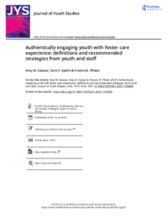Displaying 331 - 340 of 2214
This brief article from Student Affairs Today highlights some of the lessons learned by student affairs professionals regarding foster care support programs at higher education institutions in the United States in light of the COVID-19 crisis.
This paper explores within group differences for Mexican and Puerto Rican mothers vulnerable to child welfare involvement.
Using data from the Incarcerated Serious and Violent Young Offender Study, the criminal offending trajectories of 678 incarcerated youth were examined. A history of foster care predicted membership in a high rate chronic offending trajectory.
This study aims to answer two research questions: a) How do youth and staff/professionals define/conceptualize authentic youth engagement (AYE)? and b) What are youths’ and staff/professionals’ recommended strategies for authentically engaging youth?
This study aims to answer two research questions: a) How do youth and staff/professionals define/conceptualize authentic youth engagement (AYE)? and b) What are youths’ and staff/professionals’ recommended strategies for authentically engaging youth? Thirty stakeholder interviews (15 youth, 15 staff/professionals) and 81 surveys (46 youth, 35 staff/professionals) were completed.
The current study employed Interpretative Phenomenological Analysis (IPA) to guide the analysis of semi-structured interviews with eight young people with a range of care experiences, looking at the topic of confiding in others.
The current study employed Interpretative Phenomenological Analysis (IPA) to guide the analysis of semi-structured interviews with eight young people with a range of care experiences, looking at the topic of confiding in others.
The manner in which foster children present and the frightening feelings this may trigger can overwhelm the foster carers’ capacity to sustain a nurturing stance in relation to the children and jeopardise the placement. In this article, two case studies chart such a dynamic and show that if carers are able to reflect upon the painful and unwanted feelings evoked in them, and acknowledge and take responsibility for what has become enacted in the placement, there may be an opportunity for this harmful dynamic to be processed and repaired.
This article summarises the Narrative Model and shows how it supports placement stability for children.
In this article, two case studies chart show that if foster carers are able to reflect upon the painful and unwanted feelings evoked in them, and acknowledge and take responsibility for what has become enacted in the placement, there may be an opportunity for harmful dynamics to be processed and repaired.

